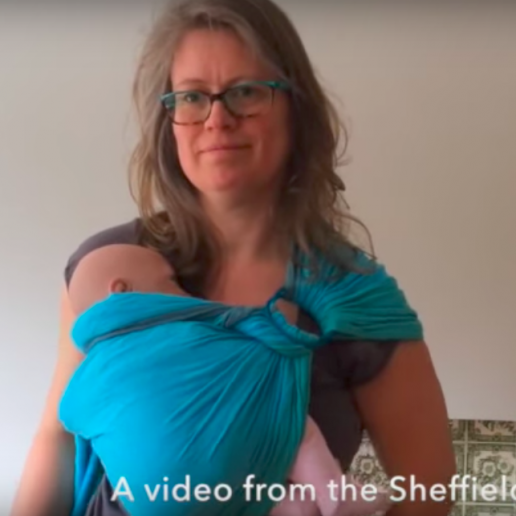Hip carriers such as ring slings can be very useful for parents who prefer a slightly “off-centre” upright positioning, or those who have children who want to see more of the world, but aren’t yet ready to consider back carrying. Hip carrying preserves the visual connection of parent-facing positions and can be very quick for mobile children who want to be up and down frequently, or for a lightweight carrier for occasional use. Hip carriers can be fabric based ring slings, pouches (for use with older babies), some buckled carriers and a few “carrying aids” that are not hands free.
Here is a quick link to a video about how to use a ring sling; as if you were having a consultation with Rosie herself and Lucy (from Little Lifts)
Like all carriers, ring slings and other hip carriers need to be used safely and the TICKS guidelines should always be followed. The most important consideration is to protect baby’s airway; a baby’s neck should never be folded in half and two fingers should fit between their chin and their chest.
The most frequently adopted position for carrying young babies is upright and facing the parent, with legs slightly spread apart (the M position) and head well supported, as this will also protect growing hips and spine. Most frequently this will be the simple upright position slightly “off-centre” from the midline, with the fabric being adjusted snugly around baby for the perfect fit. There are ways to use a ring sling to hold a baby safely in other positions, but these need to be done with care. Pouch slings are best used for babies from three to four months and up and MUST fit the adult’s body properly to be safe; loose fitting pouches can pose a risk to the airway.
Ring slings are very versatile, and can be used for front, hip or back carries as babies grow. They have been around for thousands of years in many traditional formats to allow parents to carry babies on their front or hips, from the Mexican rebozo to the Welsh babywearing shawl and the German Hockmantel.. simple, practical, incredibly useful.
“I love being able to just pop it in my bag and always have it around for emergencies, whether they be a toddler that can’t walk another step or a baby that just needs to be close.”
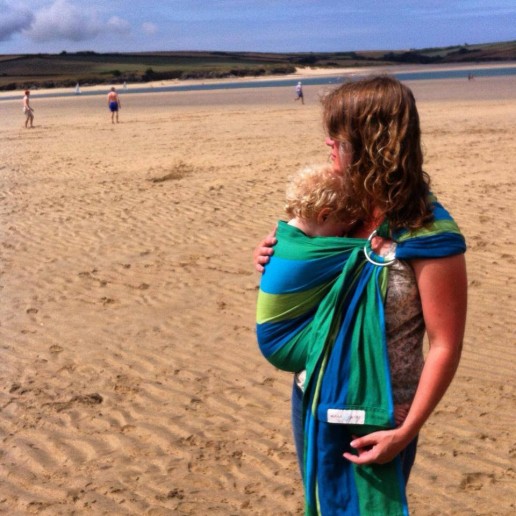
A ring sling is a piece of woven fabric usually about 2m long and 60cm wide that has one end sewn securely into two strong rings.
They are worn on one shoulder with your child sitting in a pouch on the opposite side of your body, with the loose end of the fabric threaded through the rings in such a way that the tension holds the fabric firmly and the weight is distributed across your shoulder and back.
They are derived from the ancient practice of tying short cloths around the body with a knot at one shoulder, such as the Mexican rebozo shawl (which is a multipurpose cloth).
Ring Slings are very versatile for a wide range of ages, and can pack away small, which is great for portability and convenience. Once you have the knack, they are very quick and easy to put on.
They can be used from birth, and allow preservation of the natural foetal curved position with knees tucked up into the M shape, and many babies will sleep contently in a ring sling, allowing the carrying parent to be hands free (which can be very helpful with toddlers around).
They are useful for feeding as they can provide discreet cover, or allow semi-cradled or sideways seated positions for breast or bottle access. They can be perfect for quick up-and-downs with toddlers, or to keep in the car for emergency carrying needs.
For babies who love to see where they are going (and not yet ready for back carries) a ring sling allows a comfortable off-centre or hip carry that still preserves healthy hip position. Children can see past the nearside shoulder and also look directly ahead. This position allows a child to turn its head into the carer’s chest, away from too much stimulation. Babies have not yet learned to organise and “zone out” of their multiple sensory streams, and need to be able to retreat and sleep safely.
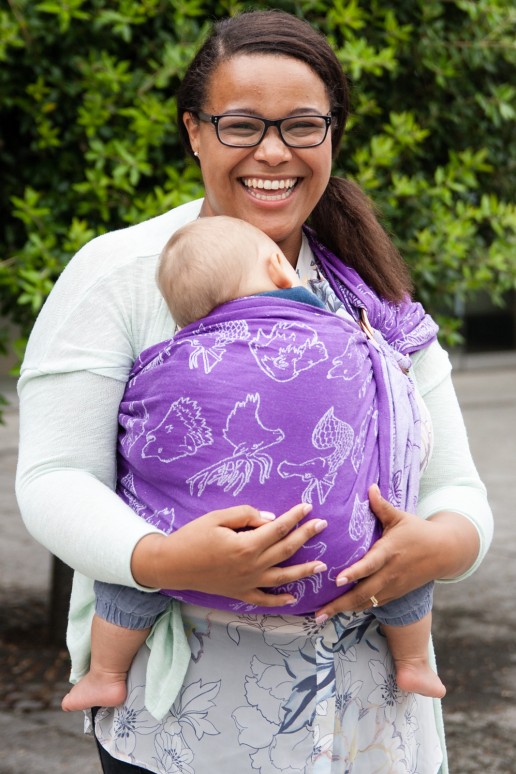
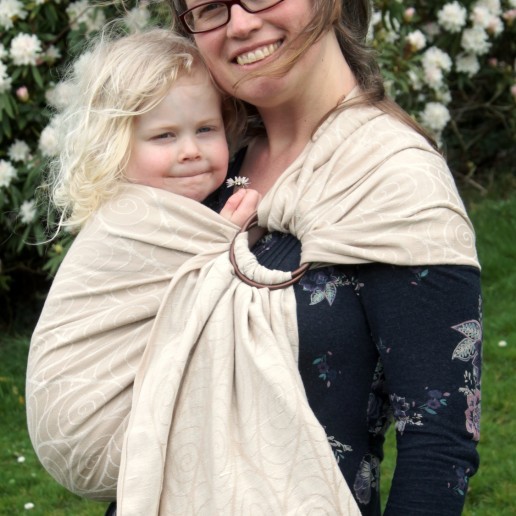
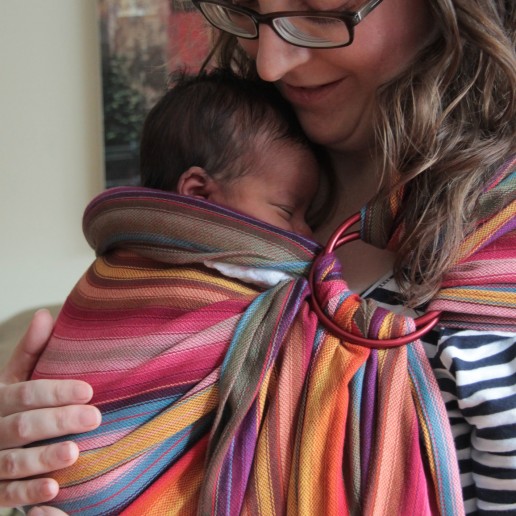
Types of Fabric
Many ring slings are converted from cotton woven wraps, as cotton is easy to care for, soft, strong and supportive. Some may be made of blends of cotton, wool, linen, hemp, silk or bamboo. These fibres can add features such as extra supportiveness, grippiness, softness or glide, and people will often have their preferences. Linen, silk and hemp are extra supportive for older children, but can be a little rougher than cotton, whereas bamboo adds softness and smoothness. Some grippier fabrics can be harder to work with, while slippy fabrics can feel as if they are loosening a little
Some ring slings will therefore be thinner and cool to wear, some are dense and blankety for extra comfort.
Wrap fabric works very well as a ring sling, as it moulds well around a child and the wearer’s shoulder and is easy to work with and tighten through rings. Ring slings made of cheaper cotton or with things like padded rails or shoulders can be much more difficult to use well and safely. I do recommend going to your local sling library to try a few out and see the difference for yourself.
“When he was little, it was such a cosy way to carry him. Cuddled in close. When he was a bit bigger, he was too curious for other carriers, and would only sit on our hips – so the ring sling was all we used for a couple of months."
Types of shoulder
The most common types are simple gathered shoulder and pleated shoulder. They are all different and most people find one style suits them best, it is worth trying a few out from the sling library or sling meet to see which works best for you; what is right for one person may not suit another.
Simple gathered shoulder; this enables a good spread of fabric across your shoulder in a cupped distribution, as well as spreading widely across your back. Most ring slings have this shoulder.
A popular variation of this is a “floating” shoulder, where the seam is sewn about 9-12 inches away from the rings. This keeps the seam behind the shoulder (which can help to keep the rings nice and high) and the double layer of fabric adds to the feel of cushiness.
Pleated shoulder (typically with knife pleats): the fabric is kept in a narrower distribution to the top of the shoulder but still spreads widely across the back.
There are many variants of pleated shoulders, such as
The Eesti shoulder is a pleat at each edge with simple gathering in the centre, it will spread widely to cup the shoulder, but less broadly than the gathered.
The box pleat shoulder (with knife pleats) is of medium width across the shoulder so keeps it a little constrained for a tidier look at the front while still spreading across the back.
Simple gathered shoulder
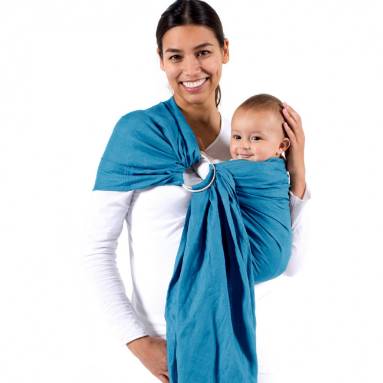
Floating gathered shoulder
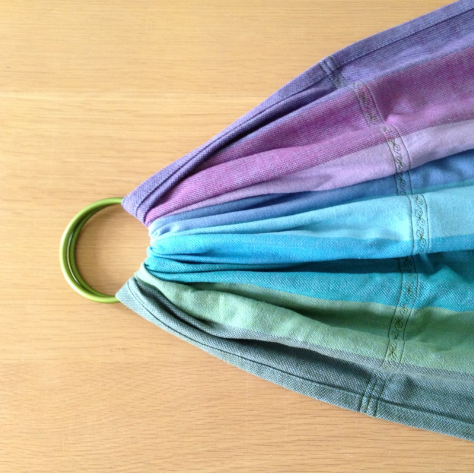
Knife pleated shoulder
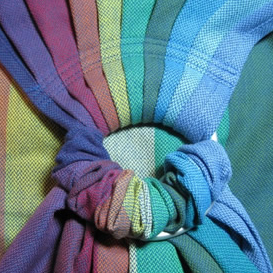
Floating pleated shoulder
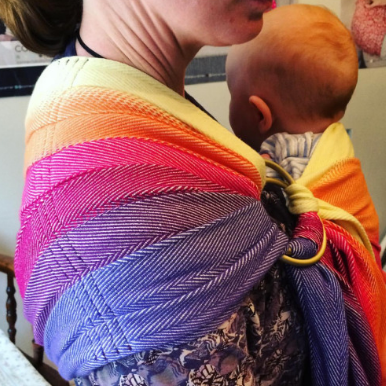
Eesti shoulder
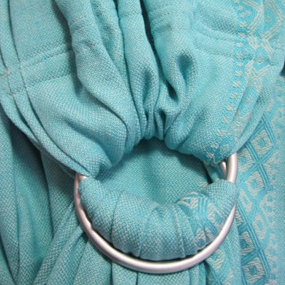
Box pleated shoulder
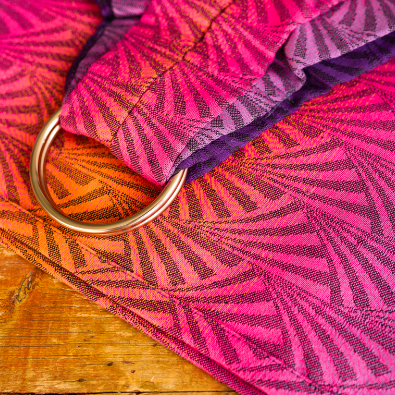
“We love how convenient it is. You can just pop him in and go. It’s the easiest way of doing short journeys where you’re taking him in and out lots. If I could only have one sling, it’d be a ring sling.”
How do I put my ring sling on?
Set your ring sling up with the long end threaded through the rings like a belt, with the lower rail a little tighter than the top rail, making a pouch.
Slip your child’s legs into the gathered rope of fabric, and sit them down with the fabric collected well into their kneepits and bottom resting lower than knees (this is the M shape that protects hips in a healthy position and provides a secure carry). Readjust the rings so they stay high, just below your collarbone.
Once this position is achieved, pull the top edge of the fabric smoothly up baby’s back to the neck, and then check that the lower edge of fabric is well tucked up into baby’s bent knees, to ensure you have a good seat. You will need to smooth any loose fabric under the baby’s knees towards the rings. Baby should be sitting in a “bowl” with the bottom third of the fabric snugly gathered in a horizontal aspect.
Spread the fabric comfortably to cup your shoulder with the rings up high, and then while holding baby securely, bring the slack of the top edge of fabric around your back, over baby’s body and towards the rings.
Find the top rail of the fabric in the section after the rings and pull the fabric through the rings in a direction slightly away from your body and over your child, rather than tugging downwards. Keep moving the fabric through the rings in sections down the width of the fabric, little bit by little bit, keeping the rings up high, until you’ve got to the bottom rail and all feels nice and snug.
Your baby’s tummy and chest should be in close contact with your body . If you find it hard to get right, do get in touch for some practical help at a library drop in or a one to one.
Learning how to use a ring sling does take a little practice. Some parents find it comes easily and have taught themselves. Others need a few goes to get it right and find a consultation or a workshop where they are taught in person helpful.
Please note that low horizontal cradle style carries are no longer recommended due to airway risk. However, semi-reclined positions where baby’s face is free of fabric can be very comfortable. For such carries or with premature or especially small babies you may find it helpful to have some help in person.
Upright front “tummy to tummy” carry with a small baby

Front carry with a four day old
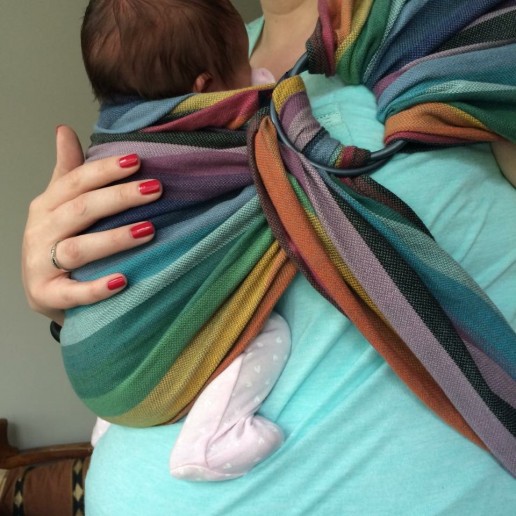
Here is a photo tutorial for a upright ring sling carry with a baby. Please click/swipe through each image.
Here is a separate link to the photo tutorial.
Toddlers love ring slings too!
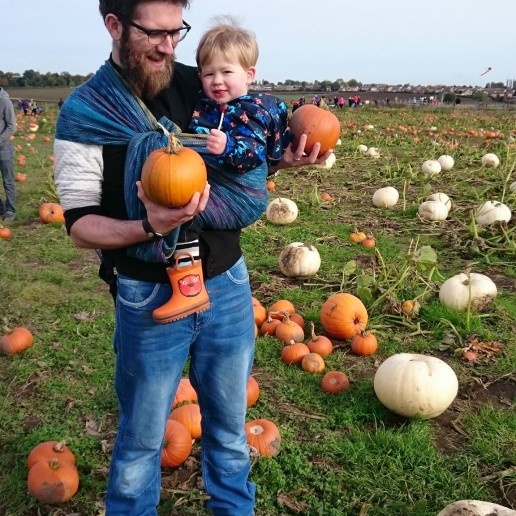
Ring slings can be used by all the family
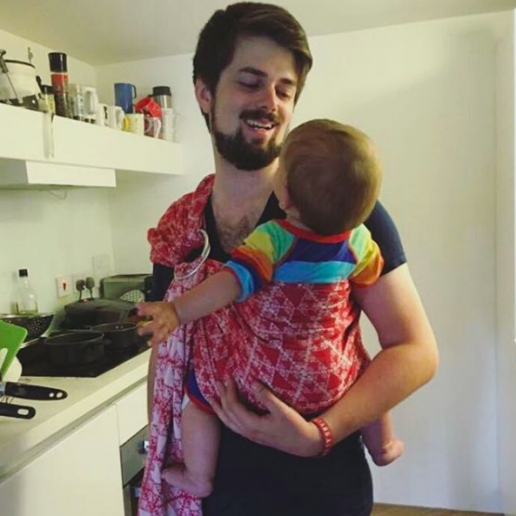
Top Tips!
- Prepare the pouch for your baby; a little snugger at the bottom third to help hold knees up, and the middle and top sections only just wider than the volume of your baby's body, so it is snug as you pull it up.
- Hold your baby straight in the centre of your chest and bring his legs through the rope pass on the front.
- Make sure he is sitting in the M shape and hold his chest close to you as you go. Getting position right at the beginning makes it much easier later.
- Keep the rings in the right place as you go; it is easier to amend ring position before you bring up the panel.
- Keep arms in if possible, and bring older babies' arms out later, once the carry is finished. Toddlers may prefer being carried arms out from the start; ensure the panel comes right up under their armpits.
- Bring all the slack from your back around to be near the rings and hold this fabric as you tighten; this stops the rings sliding down and ending up too low.
- Practice tightening the fabric strand by strand. This is key for ensuring the top, middle and bottom sections of the ring sling are snug around you and your baby.
- The middle thirds need to be snug to avoid folding and slumping over.
- An over-tight lower third will impede the formation of a seat.
- Do not tighten the top hem on its own; this can lead to over tightening and red marks. Tighten the top few inches; this will hold shoulders in.
- Lift your baby's bottom so you can spread the shoulder fabric well for comfort.
“Once you’ve got the sling in a comfortable position, it’s really easy to just pop it on the next time you use it with little adjustment. Great for a quick carry for tired toddler legs.”
Common Queries about Ring Slings
Feeding in Ring Slings
Feeding is possible in ring slings and some buckled hip carriers, with a little care to ensure baby’s airway is well protected. Typically, for breastfeeding, this involves loosening the panel in stages so baby is lowered gently to the nipple. No breastfeeding is hands free, and it is usually a good idea to get some help and advice from people who are familiar with how to do it. Please note that when baby has finished feeding, he must be returned to his safe snug upright position, close enough to kiss.
You can read more about how to breast and bottle feed here.
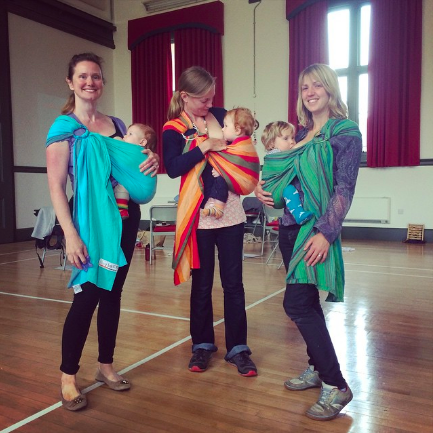
When can I start hip and back carries?
Babies can be carried “off centre” on the front from early on, as long as their natural tucked narrower M shape position is preserved. Lateral hip carries tend to work best when babies begin to sit comfortably the parent’s side, this is typically about 3 months or when baby begins to roll.
It is possible to back carry with a ring sling and many families find this a quick way of carrying an older baby. It is harder to do than the front and hip carries, but your local sling educator (find them at Sling Pages) can help. This French video is one that I like and use myself.
Read more here about beginning to back carry.
Back carry with a ring sling
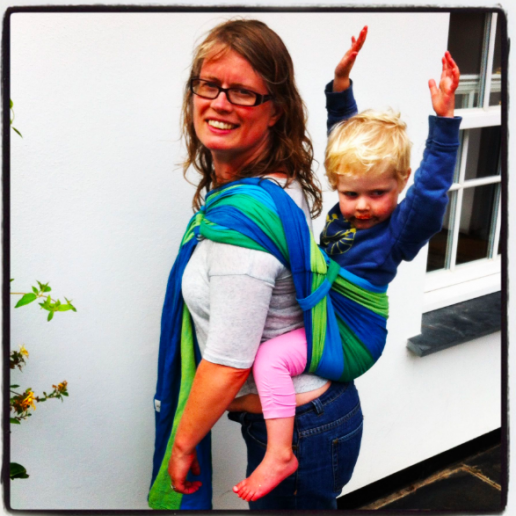
 Can I face my child forwards in a ring sling?
Can I face my child forwards in a ring sling?
Indeed you can, once they have head control (typically about 4 months). This is known as the Buddha position and some babies love it! Their legs are crossed into a buddha position with feet in front of the tummy (so weight is not placed on the ankles).
Troubleshooting your Ring Sling
- Carry feeling too loose or too low? You are likely to have too much slack in the pouch.
- Struggling to tighten it further? If the fabric is all tangled up in the rings, distributing it more evenly and freeing the hems will make it easier. New ring slings may need some "breaking in". Try to have the pouch the right size for baby to minimise how much tightening you need. Tighten in strands, in a wheel spoke pattern, lifting baby's bottom a touch as you go to reduce the weight you have to pull.
- Baby folding over or slumping over to one side? This is likely to be looseness in the middle third; leading to an unsupported back. Hold your child chest to chest and tighten around them.
- Baby's head leaning back? This is usually due to looseness of the top third of the pouch not keeping shoulders and upper body held chest to chest, o not having enough fabric up the back. Pull up more fabric if needed (a third should remain under the bum) and tighten the top third.
- Baby's face too close to the rings? Bring the pouch back down to the rope pass, and rearrange the rings, before pulling the pouch back up again. Bring the slack from behind you towards the rings before you tighten.
- Shoulder digging on your neck? Spread the fabric broadly across your shoulder to redistribute weight. Loosen the top hem a little at the rings and feed the slack back under your arm to your neck.
- Red marks at back of baby's neck? This is usually due to over tightening of the top hem of the pouch; it is the top third that needs to be snug to support the shoulders.
- Baby leg straightening? Ensure you have enough fabric tucked under the knee pits in the M shape with knees above bottom. Too tight and you won't be able to tuck this under. When you have at least a third of fabric tucked under, bring the back slack along to the near kneepit and tighten any slack.
Ring Slings can be great for weddings
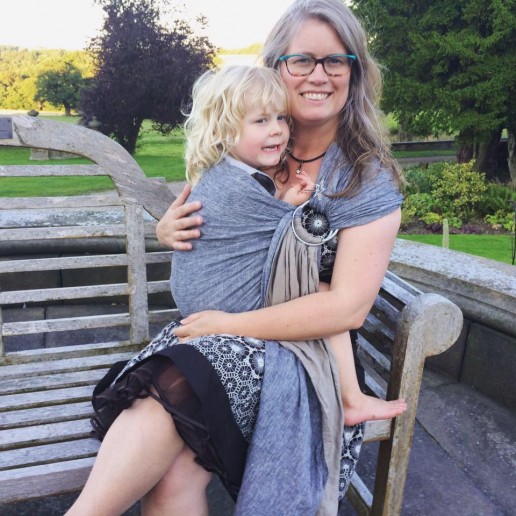
Ring Slings can be used facing out, with care
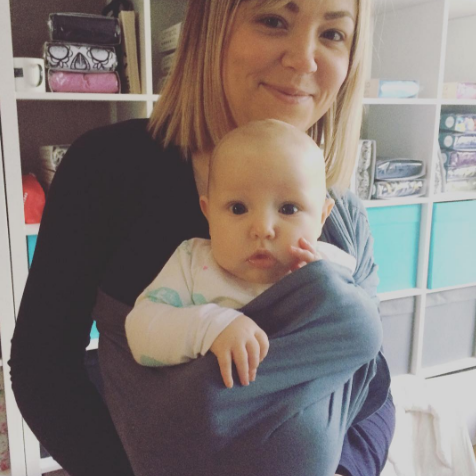
Pouches and Carrying Aids
Simpler than ring slings but very similar, pouches are “tubes” of non-stretchy fabric, usually cotton, which are folded in half along their length and then partly unfolded to make a deep pouch for baby to sit in.
You need the right size for your body shape for them to work well so they do need to be fitted, and used properly. They can be risky if used badly as it is very easy for a young baby to slip down inside the pouch and end up with the chin pressed forwards onto their chest or their face squashed against the parent. That said, once a baby is nearer four months or so with robust upper body control, pouches can be very useful for quick carries as they pack down so small.
Carrying aids are not technically slings at all, as they are not hands-free and the parent will need to support the carried child with one arm. These are things like shaped mesh cross body sashes that a child can ride on the hip (some of the weight borne by the opposite shoulder) or small shaped seats that are buckled around the parent’s waist for a child to perch on.
Buckle Hip Carriers
There are a few buckled hip carriers such as the Scootababy that support children fully and are hands free; many parents find them invaluable tools for getting on with daily life with a child held comfortably on the hip, where they usually tend to rest when in arms. They can be used for central front carrying and back carrying (with caution) and fit best from around 4months up.
Dad needs to keep a hand on baby's back for safety with this carrying aid
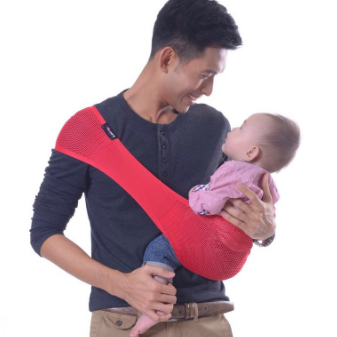
This hip carrier provides full back support
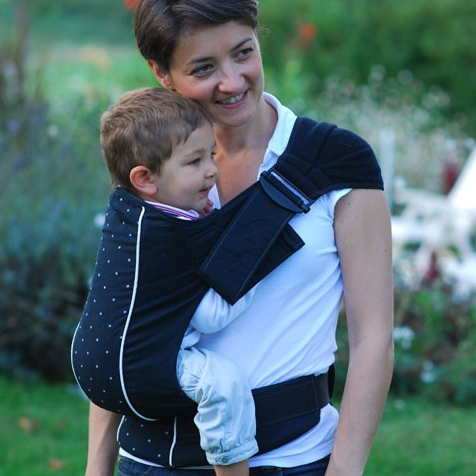
This photo (of a demonstration doll) shows the risk of low, horizontal cradle carries in bag slings and some pouches.
Please take great care if you are using any kind of reclined carry as it puts your baby’s airway at risk, it can push the chin onto the chest and restrict breathing.
Pouches MUST be the correct size for safety and are best used for babies over 3-4months.
If you would like to learn how to use a ring sling for your young baby in a semi-reclined position please get in touch with your local sling educator, who may be able to teach you how to do this safely. This video shows you one way to ensure baby is kept high in a semi-reclined carry with an open airway in a ring sling.
Unsafe, low, horizontal cradle carry in a pouch sling
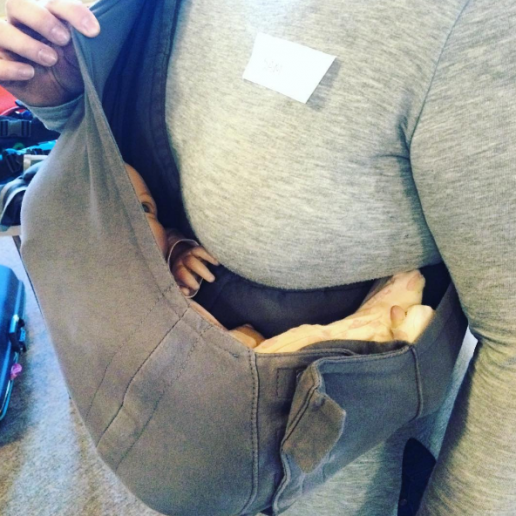
With all one shouldered carriers, it is important to build up strength and ensure frequent changes of position. If possible, swap sides to encourage balancing of the load around the body and avoid strain from repetitive weight bearing that feels comfortable at the time. If you are pregnant, or have Symphysis Pubis Discomfort, or significant back pain, one shouldered hip carries may not be the best choice for you.
If you need some more support, please get in touch with your local sling educator.

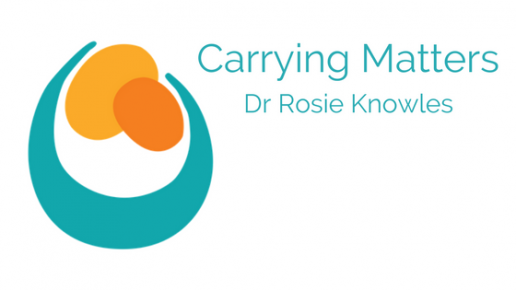
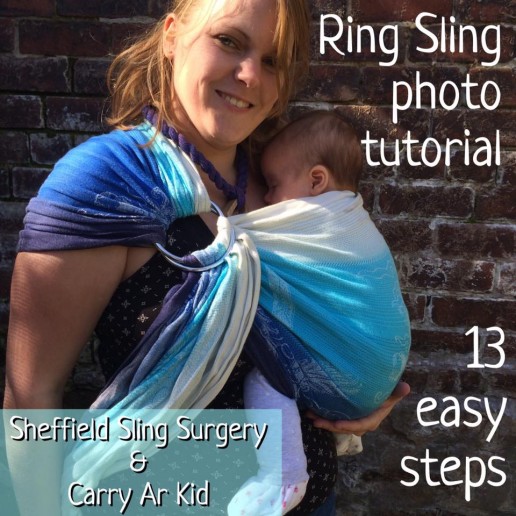
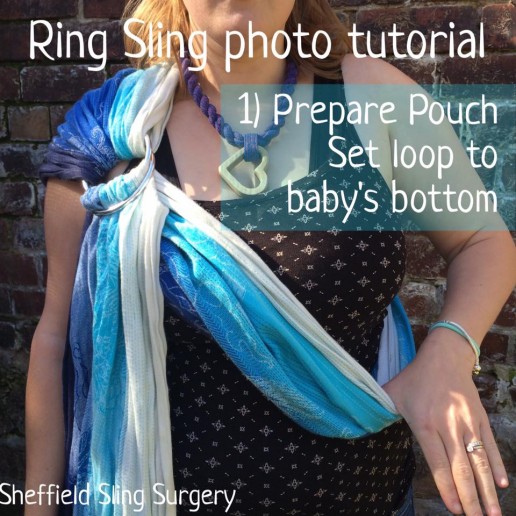
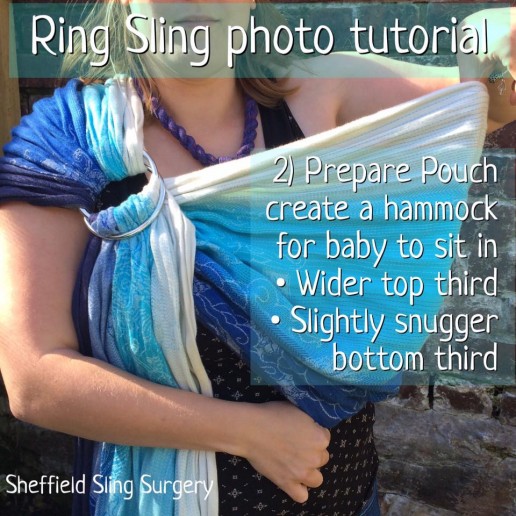
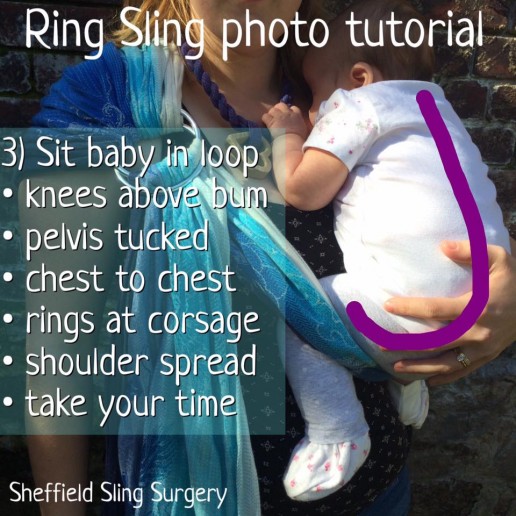
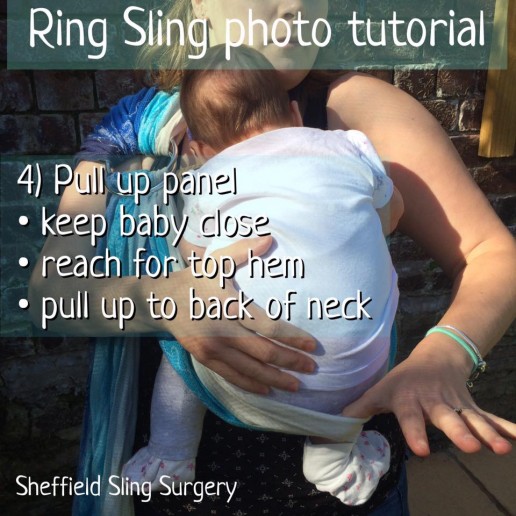
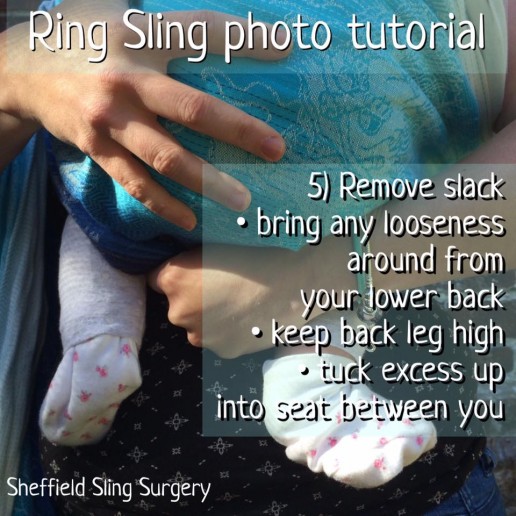
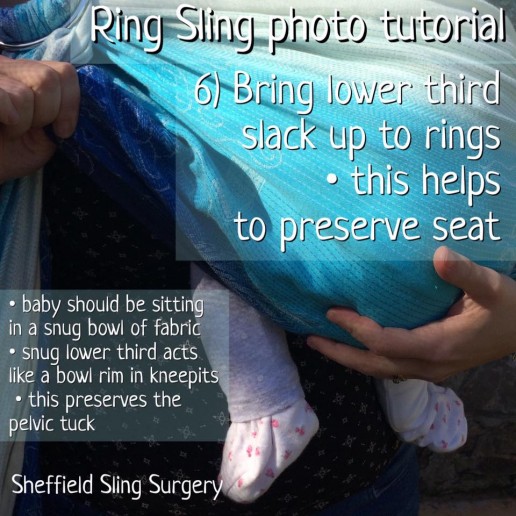
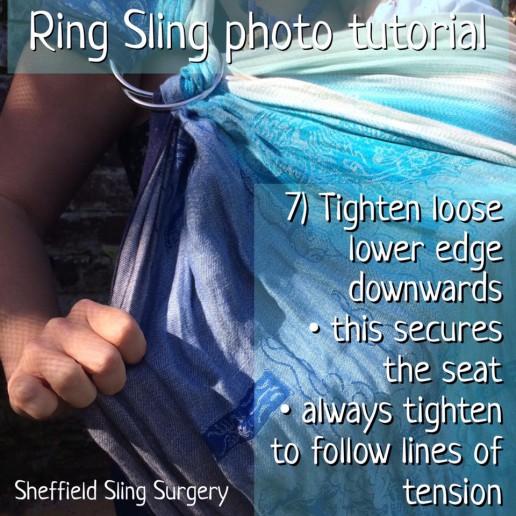
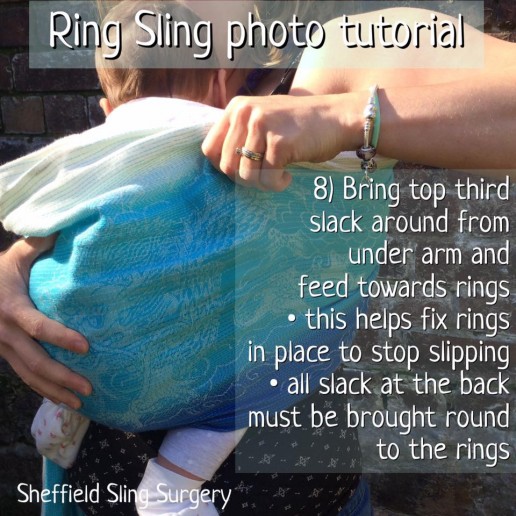
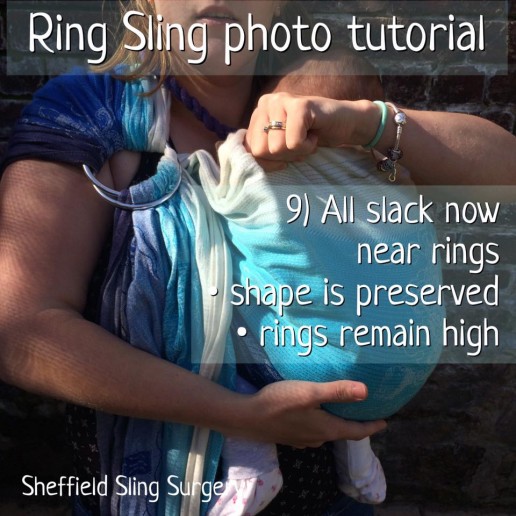
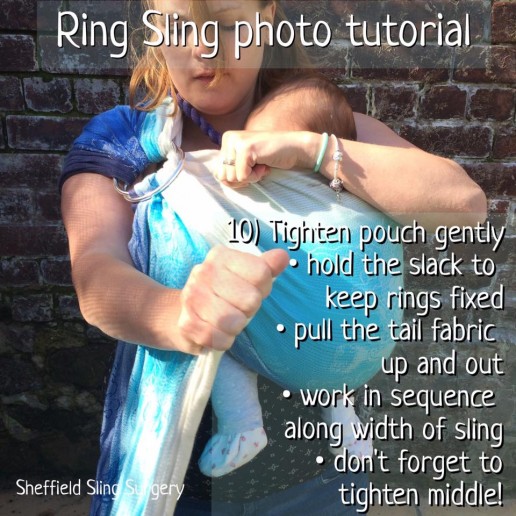
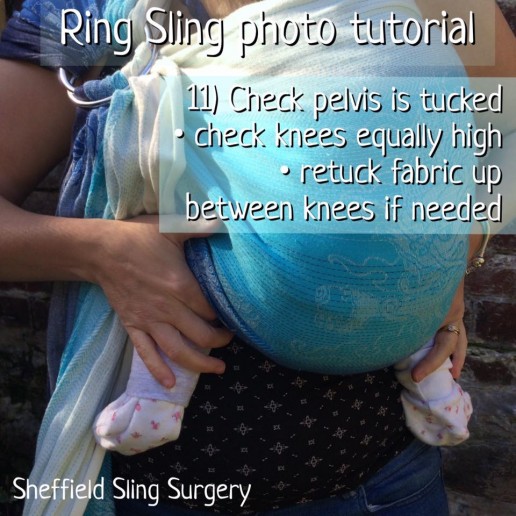
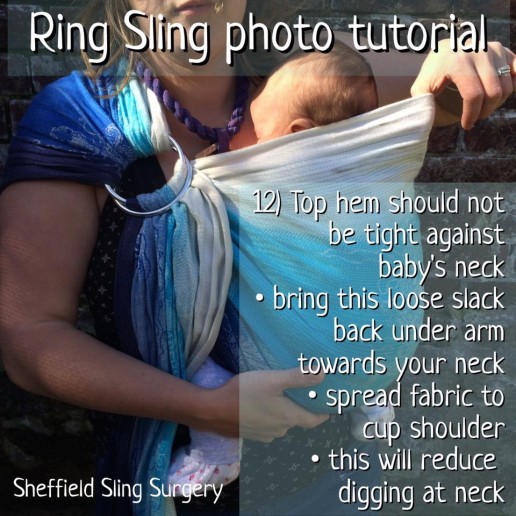
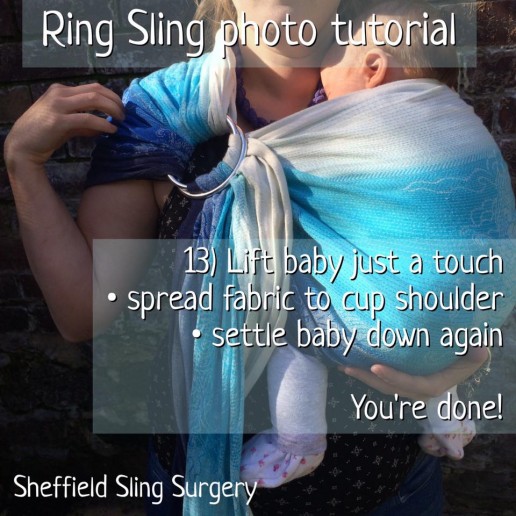
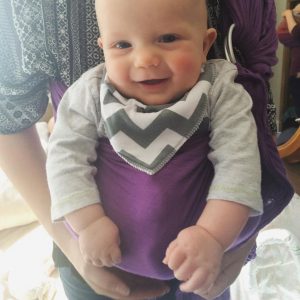 Can I face my child forwards in a ring sling?
Can I face my child forwards in a ring sling?